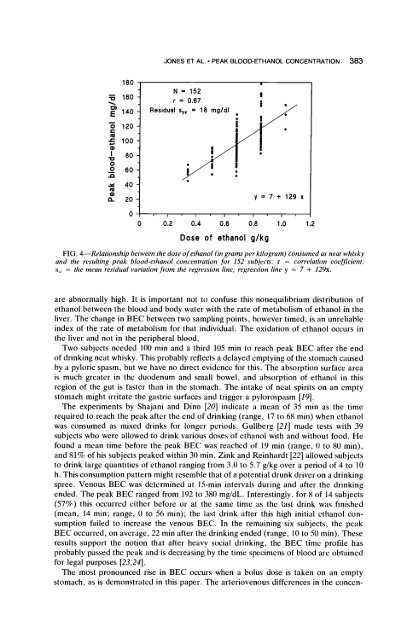Click Here for the PDF - Library
Click Here for the PDF - Library
Click Here for the PDF - Library
You also want an ePaper? Increase the reach of your titles
YUMPU automatically turns print PDFs into web optimized ePapers that Google loves.
180<br />
-~ 160<br />
E 140<br />
12o<br />
'- 100<br />
I 80<br />
0<br />
~ 6o<br />
,,a<br />
~ 40<br />
~ 20<br />
JONES ET AL. ~ PEAK BLOOD-ETHANOL CONCENTRATION 383<br />
N = 152 !<br />
r = 0.67 . / | 9<br />
Residual Syx = 18 rng/dl oi i~~<br />
y=7+129x<br />
i i i i I<br />
0 0.2 0.4 0.6 0,8 1.0 1.2<br />
Dose of ethanol g/kg<br />
FIG. 4--Relationship between <strong>the</strong> dose of ethanol (in grams per kilogram) consumed as neat whisky<br />
and <strong>the</strong> resulting peak blood-ethanol concentration <strong>for</strong> 152 subjects: r = correlation coefficient:<br />
s,~ = <strong>the</strong> mean residual variation from <strong>the</strong> regression line; regression line y = 7 + 129x.<br />
are abnormally high. It is important not to confuse this nonequilibrium distribution of<br />
ethanol between <strong>the</strong> blood and body water with <strong>the</strong> rate of metabolism of ethanol in <strong>the</strong><br />
liver. The change in BEC between two sampling points, however timed, is an unreliable<br />
index of <strong>the</strong> rate of metabolism <strong>for</strong> that individual. The oxidation of ethanol occurs in<br />
<strong>the</strong> liver and not in <strong>the</strong> peripheral blood.<br />
Two subjects needed 100 min and a third 105 min to reach peak BEC after <strong>the</strong> end<br />
of drinking neat whisky. This probably reflects a delayed emptying of <strong>the</strong> stomach caused<br />
by a pyloric spasm, but we have no direct evidence <strong>for</strong> this. The absorption surface area<br />
is much greater in <strong>the</strong> duodenum and small bowel, and absorption of ethanol in this<br />
region of <strong>the</strong> gut is faster than in <strong>the</strong> stomach. The intake of neat spirits on an empty<br />
stomach might irritate <strong>the</strong> gastric surfaces and trigger a pylorospasm [19].<br />
The experiments by Shajani and Dinn [20] indicate a mean of 35 rain as <strong>the</strong> time<br />
required to reach <strong>the</strong> peak after <strong>the</strong> end of drinking (range, 17 to 68 min) when ethanol<br />
was consumed as mixed drinks <strong>for</strong> longer periods. Gullberg [21] made tests with 39<br />
subjects who were allowed to drink various doses of ethanol with and without food. He<br />
found a mean time be<strong>for</strong>e <strong>the</strong> peak BEC was reachcd of 19 min (range, 0 to 80 min),<br />
and 81% of his subjects peaked within 31) min. Zink and Reinhardt [22] allowed subjects<br />
to drink large quantities of ethanol ranging from 3.0 to 5.7 g/kg over a period of 4 to l0<br />
h. This consumption pattern might resemble that of a potential drunk driver on a drinking<br />
spree. Venous BEC was determined at 15-min intervals during and after <strong>the</strong> drinking<br />
ended. The peak BEC ranged from 192 to 380 mg/dL. Interestingly. <strong>for</strong> 8 of 14 subjects<br />
(57%) this occurred ci<strong>the</strong>r be<strong>for</strong>e or at <strong>the</strong> same time as <strong>the</strong> last drink was finished<br />
(mean, 14 rain; range, 0 to 56 min); <strong>the</strong> last drink after this high initial ethanol con-<br />
sumption failed to increase <strong>the</strong> venous BEC. In <strong>the</strong> remaining six subjects, <strong>the</strong> peak<br />
BEC occurred, on average, 22 rain after <strong>the</strong> drinking ended (range, 10 to 50 min). These<br />
results support <strong>the</strong> notion that after heavy social drinking, <strong>the</strong> BEC time profile has<br />
probably passed <strong>the</strong> peak and is decreasing by <strong>the</strong> time specimens of blood are obtained<br />
<strong>for</strong> legal purposes [23,24].<br />
The most pronounced rise in BEC occurs when a bolus dose is taken on an empty<br />
stomach, as is demonstrated in this paper. The arteriovenous differences in <strong>the</strong> conccn-

















